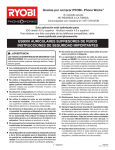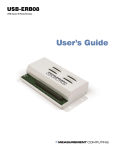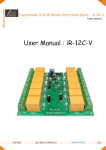Download T100MX+ (Rev D) Programmable Controller Installation Guide
Transcript
T100MX+ (Rev D) Programmable Controller Installation Guide + COMM3 RS485 COMM2 (DTE) Male DB9 +24V DC Power Supply for PLC Output LED Indicators (Red) Digital Output Terminals Analog I/Os Female DB15 connector 126mm (4.95”) To Host PC RS232C (COMM1) T100MX+ Super PLC Warning: Warranty Void if this label is damaged 0V 62256LP-12 CMOS RAM Digital Input Terminals 183mm (7.2”) Input LED Indicators (Green) Figure 1 - T100MX-3224R+ PLC 1. Introduction The T100MX+ is a family of powerful programmable controllers. It is a close sibling of the other popular M-series PLCs: the T100MD+ PLCs. The main difference between the two families is that the T100MX+ has 3 serial ports but no built-in LCD port, whereas the T100MD+ has a built-in LCD port but eliminated the second RS232 serial port. Yet another difference being that T100MX+ employs bi-directional opto-isolated input drivers which can interface to both the PNP and the NPN type of inputs. The first RS232 port COMM1 on the T100MX+ is also opto-isolated. Other than that, the T100MX+ and T100MD+ PLCs operate identically from the programming point of view. The M-series PLCs underwent one major hardware and firmware upgrade in 1999 to give them even more powerful communication ability. The latest hardware revision of the M-series PLC is “Rev D”. All Rev D designs are clearly marked along the right edge of the PCB board. This installation guide describes mainly the hardware applicable only to the T100MX+ PLC. For detailed description of the special I/Os and communication protocols which are common to both the T100MX+ and T100MD+ PLCs, please refer to the T100MD+ User’s Manual. 1 T100MX+ PLCs Chapter 1 : Installation Members of the T100MX+ differ only in their digital ON/OFF I/O combination. We will be introducing a few standard models from 32 to 128 I/Os. Special I/O combinations can also be custom-made for OEM customers requiring more than 300 PLCs per year. Models of T100MX+ PLC are defined as follows: T 1 0 0 M X - 3 CPU Type 2 No. of Inputs 2 4 R + No. of Outputs With some Relay Outputs In the above example T100MX-3224+ means that the PLC has 32 ON/OFF type inputs and 24 ON/OFF type outputs. The “R” indicates that some of the outputs are relay type. Models with only transistor-outputs do not carry the “R” label. If you include the 8 channels of analog I/Os, the PLC will have a total of 32 + 24+ 8 = 64 I/Os. 2. Physical Mounting & Wiring The compactly designed T100MX+ PLCs can be easily installed in many kinds of plastic or metal enclosures. You need to use 4, 6 or 8 PCB standoffs (or some screws and nuts) to support the controller and to fasten it to a console box. Screw terminals are provided for quick connection to all input and output wires. In addition, each block of screw terminals can easily be detached from the controller body, enabling easy replacement of the controller board when necessary. Maximum AWG 24 wire Insulated crimp ferrules Tightening screw Connecting-pin strip Flat-head screw driver Figure 2 - Removing screw terminal block Detachable screw terminal blocks are provided for quick connection to all inputs, outputs and power supply wires. Since the terminal block is inserted vertically to the board surface, you need to remove the terminal block before you can start wiring. Insert a small flat-head screw-driver underneath the terminal block and apply even pressure to raise the terminal block until it becomes loosened from the connecting-pin strip, as shown in Figure 2. 2 T100MX+ PLCs Chapter 1 : Installation 3. Power Supply The small T100MX+ PLCs such as the T100MX-3224R+ require a single regulated +24V DC power supply. Although the PLC’s CPU can actually run at voltages as low as 12V DC, its built-in electromechanical relays require at least +17V to operate reliably. For all transistor-output models (e.g., the T100MX4832+), the PLCs can operate at much wider voltage range of between 12 to 24V DC power supply. Although the PLC can use either linear or switching power supply, please take note that if you require very accurate analog reading from the on-board ADC, then you should use only a good linear power supply that is free of ripples. Switching power supply are well known to be noisy and can affect the accuracy of analog reading, The higher I/O models such as T100MX-4832+ also possess two separate power connectors: One is the “CPU power” and the other marked the “I/O power” as shown in Figure 3. These two power connectors are internally connected on the Rev D version of T100MX-4832+. Hence you should use a single regulated, 12V to 24V DC power supply (+/-5% fluctuation) to connect to both power supply inputs. Using separate wires for the CPU and the I/O help to reduce the noisy load power from the CPU power. 24V Regulated DC Power Supply (Use separate wires from power supply) + 0V +24V 0V T100MX Programmable Controller CPU Power Power I/O Power + - Figure 3 - Connecting Power Supply Please use two separate pairs of wires to connect the power supply to the CPU section and the I/O section, as shown in Figure 3. The required current rating for the power supply depends mainly on the total output current, taking into consideration the peak current demand and the duty cycle of the operation. 4. Input Circuits Examine the silk-screen markings on the T100MX+ PCB and you should be able to find markings such as “Input 1-8”, “Input 9-16”, etc. which indicate the 3 T100MX+ PLCs Chapter 1 : Installation locations of the Input terminals. All inputs have green color LED indicators. Every 8 inputs are grouped together into a single strip of detachable screw terminal and it shares a single COM (common) terminal. All inputs employ bi-directional opto-isolators and they can be connected to either PNP (source current) or NPN (sink current) types of sensor-outputs. The input numbers are marked on their screw terminals as well as on the PCB alongside the strip pin. 0 1 2 3 4 5 6 7 Figure 4 - Opto-isolated input interface COM T100MX PLC Other Inputs NPN Sensor Outputs T100MX PLC Other Inputs PNP Sensor Outputs T100MX Input T100MX Input COM COM 0V + DC 9 to 24V Power Supply for sensor + 0V DC 9 to 24V Power Supply for sensor Figure 5 - Input Interfacing to PNP and NPN type sensors 4 T100MX+ PLCs Chapter 1 : Installation T100MX Controller Limit Switch (Normally Open) 1 2 3 4 INPUTS 5 +12 to 24V DC Power Supply 6 + (-) - (+) 7 8 COM Input = Logic 1 when switch is closed Figure 6 - Input Interfacing to Limit Switches Inputs Electrical Specification: Specification: Input Voltage for Logic 1: +9V to +24V, > 4 mA Input Voltage for Logic 0: Open Circuit or leakage current < 1 mA. 5. Output Circuits Examine the silk-screen markings on the T100MX+ PCB and you should be able to find markings such as “Output 1-8”, “Output 9-16”, etc. which indicate the locations of the output terminals. All outputs have red color LED indicators. An output may be a power transistor or a relay type: Transistor Outputs T100MX Controller OUTPUTS 1 LOAD 2 LOAD 3 LOAD 4 LOAD 5 LOAD 6 LOAD 7 LOAD 8 LOAD 12-24V DC Power Supply +V 0V GND I/O Power + (Use separate wires from power supply) - Figure 7 - Transistor Output Interfacing to Load 5 T100MX+ PLCs Chapter 1 : Installation All T100MX+ PLCs employ “sink” (NPN) type power transistor outputs that turn ON by sinking current from the load to the ground. Every 8 outputs are grouped together into a single strip of detachable screw terminal and they share a single GND (ground) terminal. These "GND" terminals provide the return paths of the sunk current back to the power source and hence must be connected to the 0V terminal of the power supply. IMPORTANT To minimize the effect of switching noise, use a separate pair of cables to connect the "I/O Power" terminal to the power supply. If many high current loads are to be switched, then you should also use a separate cable to connect each "GND" terminal to the 0V of the power supply. That is, each ground should be terminated only at the power supply source. Parallel connection from terminal to terminal is not recommended, as illustrated in the following diagram. Output Terminals Output Terminals Power Supply GND Power Supply GND - - Figure 8 - Preferred Wiring Method of GND terminals Transistor Outputs Electrical specifications: Output #5 to #8 Output Driver type Maximum Output Current: Continuous Output Current (with all other outputs ON) Output Voltage when OFF Output Voltage when ON: @ Iout = 700 mA NPN Darlington Power Transistors All Other Transistor Outputs (1- 4, 8-16, ...) N-Channel power MOSFET with low rDS = 1 Ω 1.0A 1.0A 250mA 350mA Resistor pulled up to V+ of the I/O power 1.2V 0.7V 6 T100MX+ PLCs Chapter 1 : Installation Inductive Back EMF Bypass Yes Yes Short Circuit Protection No Yes (Built-in current limiter) +24V Power Supply T100MX+ PLC Output Output Driver LOAD - L + ( Bypass diode for heavy inductive load ) 0V Figure 9 - Suppression of inductive kick. Note: When driving large inductive loads which are situated far away from the controller, try to connect an external bypass diode across the load to suppress inductive noise, as shown in the above diagram. Relay Outputs Some relay outputs are provided on models such as the T100MX-3224R+. These are all normally-open, voltage-free relay outputs. Every 8 outputs share a common terminal (COM). Each output has an LED indicator adjacent to its terminal which lights up when the output is turned ON. T100MX+ PLC 1 LOAD 2 LOAD 3 LOAD 4 LOAD 5 LOAD 6 LOAD 7 LOAD 8 LOAD Relay1 Relay2 Relay3 Relay4 Relay5 Relay6 Relay7 Relay8 Load Power AC or DC COM OUTPUTS Figure 10 - Relay Output interfacing to load 7 T100MX+ PLCs Chapter 1 : Installation Relay Outputs Electrical specifications: Output type Current Rating : Relay contacts, Normally-open. @24V DC : 2A (Electrical life = 2 x 105 cycles) @250V AC : 2A (Electrical life = 2 x 105 cycles) @125V AC : 3A (Electrical life = 2 x 105 cycles) Maximum total current +24V : 5A (per block of 8 outputs) (a) (b) Inductive bypass AC Power diode (DC only) Varistor or Transorb (c) Varistor or Transorb AC Power Diode's reverse break down voltage should be at least 2 x load voltage Figure 11 - (a) Inductive snubber circuit - DC load only. (b), (c) Inductive snubber circuit - AC/DC load. Note: When switching inductive load, always ensure that either a varistor or bypass diode is connected to absorb inductive kick which occurs when the relay contact opens. If left unchecked, the inductive kick causes an electric arc to form across the contact which will wear out the contact material and severely shorten the contact life of the relay. 6. Analog I/Os The 8 analog I/O channels and the analog reference voltage are available on a DB15 female socket as shown below: Signal Pin # A/D #1 A/D #2 A/D #3 A/D #4 A/D #5 A/D #6 A/D #7 or D/A #1 A/D #8 or D/A #2 AVCC AVSS 8 7 6 5 4 3 2 1 13 - 15 9 - 11 8 T100MX+ PLCs Chapter 1 : Installation Note that pin #2 and #1 are A/D inputs (AD7 and AD8) after system RESET. You may configure either one or both of them as D/A outputs by executing the “setDAC” command on the respective channel(s). After that they will stay on as D/A outputs until a system RESET has been performed. You have to provide a precise +5V Reference voltage to the AVcc pins (pin #13, 14 or 15) and connect the 0V of the Reference voltage to the AVss pins (pin #9,10 or 11). Please note that although there is a +5V voltage at pin #12 which is the digital power supply to the CPU, it is available for factory-testing purpose only. You should not use this voltage as the analog reference voltage unless it is a very simple potentiometer application only. CAUTION! The analog signals on the DB15 connector are unbuffered and goes directly to the T100MX+ CPU. Users are cautioned to exercise great care when connecting any analog voltages to the T100MX+’s analog port. Any wrong voltages connected to the port pin which exceeds the absolute maximum ratings can damage the CPU instantly. Such damage will not be covered by warranty. When connecting the analog input to an external analog device, you may like to add a 2.2K resistor in series with the analog signal to limit input current and this can help to protect against accidental or induced overvoltage to the input pins. Absolute Maximum Ratings AVCC : -0.3V to +7.0V with reference to 0V of the CPU’s power. Analog Input: -0.3V to AVcc + 0.3V (Note that this means the AVCC and AVSSmust be connected before the analog input voltage is connected to the A/D pin. A/D Electrical Characteristics No. of A/D Channel Resolution: Built-in Sample & Hold Conversion Time : 8 (without D/A) or 6 (with 2 D/A). :10-bit (normalized to 12-bit by ADC(n)) : Yes. :10µs per channel. D/A Electrical Characteristics No. of D/A channel Resolution: Conversion Time Output voltage : 2 (if enabled). : 8-bit (normalized to 12-bit in SETDAC) : 10µs per channel. : 0V to AVcc 9 T100MX+ PLCs Chapter 1 : Installation 7. Serial Communication All T100MX+ PLCs feature two built-in RS232C ports (COMM1 and COMM2) and one built-in RS485 port (COMM3). Note that all three serial ports are independent and may operate simultaneously. COMM1 and COMM3 are functionally identical to those on the T100MD+ PLCs. Please refer to the T100MD+ User’s Manual for detailed description of the operations of these two ports. However, COMM1 on the T100MX+ is implemented with opto-isolated interface design whereas on the T100MD+ the COMM1 is implemented using only transistor level shifters and is not opto-isolated. 7.1 COMM1: RS232C Port with Female DB9 Connector This port is configured as a DCE (Data Communication Equipment) and is designed to connect directly to the PC’s serial port using a common PC type RS232 cable. It is an opto-isolated port for T100MX+. COMM1 communicates with the host computer at a default maximum baud rate of 38,400 bit-per-second. If DIP switch SW1-4 is set during power-on, COMM1 default baud rate will be changed to 9600 baud. This is the main communication port for program transfer and on-line monitoring of the PLC. The pin connections with the host PC are shown below: Figure 12 - Connecting COMM1 with PC For T100MX+, the opto-isolated interface taps a +9V power from the host PC’s serial port DTR signal pin, hence it is necessary for the host PC to activate its DTR (Data Terminal Ready) pin (pin #4) to logic ‘1’. The programming software TRiLOGI automatically turns ON DTR pin when it is running. However, for the user’s own communication routine to work properly, this requirement must be met. (See BASIC and C example programs “Host485.bas” and “Host485.exe”) Connecting COMM1 to Other RS232 Devices You may also connect COMM1 to another DCE device (e.g., a modem) on the condition that the other device is able to supply a +9V to pin 4 of the 10 T100MX+ PLCs Chapter 1 : Installation T100MX+ PLC. You will need to make a special cable which swap the transmit and receive signals, as follow: T100MD COMM1 (Female DB9) 1 2 3 4 5 6 7 8 9 Special cable 1 2 3 4 5 6 7 8 9 Modem (Female DB9) Figure 13 - Connecting COMM1 to a MODEM Pin 4 and 6 are handshaking signals whose presence may be required by some modems to work properly, so these pins are connected as shown in the diagram. However, some modems may not have sufficient drive current on their DSR (pin #6) to supply to the PLC’s opto-isolated interface. If you find that the modem is not responding to commands from the PLC (such as putting it to auto answer mode) then you can use a separate 9V battery or external power supply to power up the Opto-isolated RS232 circuits of the PLC as shown below. DB9 Male 2 3 4 6 5 To PLC COMM1 (Female) DB9 Male 2 3 4 6 5 Female DB9 plug modem cable MODEM + - 9V Figure 14 - Connecting COMM1 to a modem with weak DTR line 7.2 COMM2: RS232C Port with Male DB9 Connector This port is configured as a DTE (Data Terminal Equipment, similar to the PC) and is designed to connect directly to peripherals such as bar code scanner, serial printer and modem using the cable supplied with the equipment. (These cables are normally meant for connecting to a PC.) You can also use this port to send “Host-Link Commands” to another M- or Hseries PLC to activate certain program sequences. This RS232C port is not opto-isolated but it generates true RS232 voltage levels (-9V to +9V) and it has a +9V available on its DTR pin (pin #4). This 11 T100MX+ PLCs Chapter 1 : Installation means it can be used to power up other opto-isolated serial interfaces (such as those on another T100MX+ or H-series PLC). PC Connection If you wish to connect COMM2 to a PC such as for data acquisition purpose, you need a “null-modem” which is a cable that crisscrosses the transmit/receive and control-signal lines, as follow: T100MX COM2 (Male DB9) 1 2 3 4 5 6 7 8 9 Null Modem 1 2 3 4 5 6 7 8 9 Host PC (Male DB9) Figure 15 - Connecting COMM2 to a host PC Baud Rate and Communication Format Unlike COMM port 1 and 3 which operate over a much wider range of baud rates and communication formats, COMM2 is fixed to communicate only at 8 data bit, 1 stop bit and no parity. Its baud rate however may be defined from 2400 bps to 19200 bps as shown in the following table: SETBAUD Table for COMM2 Baud Rate No. 1 2 3 4 Transmission Speed 2400 bps 4800 bps 9600 bps (default) 19200 bps E.g. to set COMM 2 baud rate to 19200, simply execute the following statement within a custom function: SETBAUD 2,4 8. Trouble-shooting: Trouble-shooting: If you can’t communicate with the PLC… Unable to communicate with the PLC at all If this is your first encounter with a T100MX+ or T100MD+ PLC and you could not get TRiLOGI to talk to the PLC at all either to transfer a program or to 12 T100MX+ PLCs Chapter 1 : Installation perform on-line monitoring, then please refer to the User’s Manual for possible causes of error and the solutions No communication after transferring a new program If you have been communicating with the PLC successfully, then all of a sudden, after transferring your new TBASIC program, you keep encountering “Communication error” and could not resolve the problem. Turn DIP switch position #4 to ON position, this forces the PLC to stop executing its ladder program. Now try to communicate again. If it works it proves that your program is not well-behaved thus affecting communication with the Host PC. Debug your program to remove offending program codes which could have locked up the CPU so that it does have time to talk to the host at all. If there is still no communication, then with DIP switch #4 set at ON position, reset the PLC (by first turning OFF the PLC’s power and then back to ON again). If you are now able to communicate, then transfer a blank program to the PLC to overwrite the existing one. If none of the above works, your PLC could have been damaged. Please send your PLC to an authorized dealer for inspection and repair. 13





























